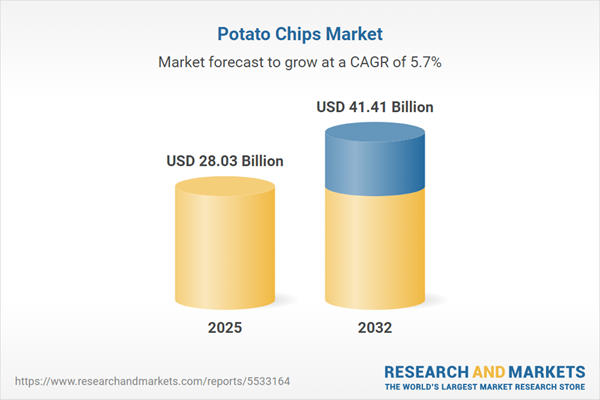Speak directly to the analyst to clarify any post sales queries you may have.
The potato chips market is experiencing dynamic shifts driven by changing consumer preferences, health-conscious innovation, and expanding digital sales channels. Senior decision-makers seeking competitive advantage will benefit from actionable insights into category transformation and global strategic trends.
Market Snapshot: Potato Chips Market Growth Outlook
The global potato chips market grew from USD 26.54 billion in 2024 to USD 28.03 billion by 2025. Projected to expand at a CAGR of 5.71%, the market is expected to reach USD 41.41 billion by 2032. This robust growth trajectory reflects accelerating consumer interest in better-for-you snacks, continuous flavor innovation, and increased investments in premium and sustainable products.
Scope & Segmentation: Comprehensive View of the Potato Chips Market
This report dissects the market by product type, flavor, packaging, price tier, end user, distribution, and geography, providing actionable segment-level intelligence for strategic planning.
- Distribution Channels: Convenience stores, hypermarkets, supermarkets, and online retail platforms.
- Product Types: Baked, kettle-cooked, multigrain, standard (including low salt and regular salted), and wavy chips.
- Flavor Varieties: Barbecue, cheese, salted, sour cream & onion, plus a range of regional and globally inspired options.
- Packaging Types: Box, lay-flat pouch, stand-up pouch, tube, and can formats designed for varied usage and shelf appeal.
- Price Ranges: Economy, mid-range, and premium offerings align with both value-conscious and upscale consumer segments.
- End Users: Commercial channels (food service, institutional buyers) and household consumers, with distinct purchasing motivations and product needs.
- Geographic Regions:
- Americas: United States, Canada, Mexico, Brazil, Argentina, Chile, Colombia, Peru
- Europe, Middle East & Africa: United Kingdom, Germany, France, Russia, Italy, Spain, Netherlands, Sweden, Poland, Switzerland, United Arab Emirates, Saudi Arabia, Qatar, Turkey, Israel, South Africa, Nigeria, Egypt, Kenya
- Asia-Pacific: China, India, Japan, Australia, South Korea, Indonesia, Thailand, Malaysia, Singapore, Taiwan
Key Takeaways for Senior Decision Makers
- Health-oriented reformulations, such as reduced sodium and alternative oils, are gaining ground due to wellness-focused consumer demand.
- Sustainability initiatives—including compostable packaging and ethical sourcing—are influencing brand positioning and buyer behavior.
- Digital commerce and direct-to-consumer sales models foster rapid product innovation and improved consumer insights.
- Global supply chain adjustments and near-shoring are enhancing operational resilience in response to regulatory and logistical complexity.
- Localized flavor innovation is driving differentiation, with regional preferences shaping product portfolios worldwide.
- Premiumization and packaging variety are directly correlated with growing market segments seeking elevated snacking experiences.
United States Tariffs: Strategic Implications for Supply Chains
The 2025 introduction of new US tariffs on imported palm and sunflower oils has raised input costs and prompted manufacturers to re-examine sourcing and procurement strategies. These regulatory headwinds have led to domestic ingredient adoption, optimized logistics, and recipe innovation aimed at sustaining competitiveness. Companies investing in regional production hubs and bulk purchasing cooperatives are adapting quickly to maintain stable margins and efficient operations.
Methodology & Data Sources
The analysis is based on a combination of primary interviews with major manufacturers, suppliers, and retail executives; structured surveys of industry associations; and in-depth consumer focus groups. Secondary research from trade journals, regulatory databases, and company filings provided breadth and context. Data triangulation and expert validation processes ensure robust, reliable intelligence for decision-making.
Why This Report Matters for B2B Decision-Makers
- Enables strategic investment by offering insight into key segment drivers, competitive innovations, and evolving distribution landscapes.
- Equips senior leaders to anticipate regulatory impacts and sustainability trends shaping forward-looking strategies.
- Supports product development, channel expansion, and supply chain optimization through comprehensive qualitative and quantitative findings.
Conclusion: Actionable Insights to Secure Sustainable Growth
This report provides a clear framework for navigating the evolving potato chips market, highlighting how health, sustainability, and digital integration are re-shaping competition. Business leaders can leverage these findings to drive innovation, enhance resilience, and strengthen market position.
Additional Product Information:
- Purchase of this report includes 1 year online access with quarterly updates.
- This report can be updated on request. Please contact our Customer Experience team using the Ask a Question widget on our website.
Table of Contents
3. Executive Summary
4. Market Overview
7. Cumulative Impact of Artificial Intelligence 2025
Companies Mentioned
The companies profiled in this Potato Chips market report include:- Frito-Lay, Inc.
- Kellogg Company
- Calbee, Inc.
- Intersnack Group GmbH
- The Campbell Soup Company
- Utz Brands, Inc.
- Herr Foods Inc.
- Grupo Bimbo, S.A.B. de C.V.
- Conagra Brands, Inc.
Table Information
| Report Attribute | Details |
|---|---|
| No. of Pages | 188 |
| Published | October 2025 |
| Forecast Period | 2025 - 2032 |
| Estimated Market Value ( USD | $ 28.03 Billion |
| Forecasted Market Value ( USD | $ 41.41 Billion |
| Compound Annual Growth Rate | 5.7% |
| Regions Covered | Global |
| No. of Companies Mentioned | 10 |









